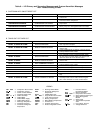
If the transducer value is not within the calibration range,
the transducer will return to the original reading. If
the LID pressure value is within the allowed range (noted
above), check the voltage ratio of the transducer. To ob-
tain the voltage ratio, divide the voltage (dc) input from
the transducer by the supply voltage signal, measured at
the PSIO terminals J7-J34 and J7-J35. For example, the
condenser transducer voltage input is measured at PSIO
terminals J7-1 and J7-2. The voltage ratio must be be-
tween 0.80 vdc and 0.11 vdc for the software to allow
calibration. Pressurize the transducer until the ratio is within
range. Then attempt calibration again.
4. A high pressure point can also be calibrated between
240 and 260 psig (1655 and 1793 kPa) by attaching a
regulated 250 psig (1724 kPa) pressure (usually from a
nitrogen cylinder). The high pressure point can be cali-
brated by accessing the transducer on the Status01 screen,
highlighting the transducer, pressing the SELECT soft-
key, and then increasing or decreasing the value to the
exact pressure on the refrigerant gage. Press ENTER
to finish. High altitude locations must compensate the
pressure so that the temperature/pressure relationship is
correct.
If the transducer reading returns to the previous value and
the pressure is within the allowed range, check the volt-
age ratio of the transducer. Refer to Step 3 above. The
voltage ratio for this high pressure calibration must be
between 0.585 and 0.634 vdc to allow calibration. Change
the pressure at the transducer until the ratio is within the
acceptable range. Then attempt calibrate to the new pres-
sure input.
The PIC will not allow calibration if the transducer is too
far out of calibration. A new transducer must be installed
and re-calibrated.
TRANSDUCER REPLACEMENT — Since the transduc-
ers are mounted on Schrader-type fittings, there is no need
to remove refrigerant from the vessel. Disconnect the trans-
ducer wiring by pulling up on the locking tab while pulling
up on the weather-tight connecting plug from the end of the
transducer. Do not pull on the transducer wires. Unscrew
the transducer from the Schrader fitting. When installing a
new transducer, do not use pipe sealer, which can plug the
sensor. Put the plug connector back on the sensor and snap
into place. Check for refrigerant leaks.
Make sure to use a backup wrench on the Schrader fit-
ting whenever removing a transducer.
Control Algorithms Checkout Procedure — The
Control Algorithm Status table is in the LID Service menu.
The ControlAlgorithm Status table contains maintenance tables
that may be viewed in order to see how the particular control
algorithm is operating. The tables are:
MAINT01 Capacity
Control
This table shows all values that
are used to calculate the chilled
water/brine control point.
MAINT02 Override
Status
Details of all chilled water control
override values are viewed here.
MAINT03 Surge/
HGBP
Status
The surge and hot gas bypass
control algorithm status is viewed
from this screen. All values deal-
ing with this control are displayed.
MAINT04
(PSIO
Software
Version 09
and Higher)
LEAD/LAG
Status
This screen indicates LEAD/LAG
operation status.
OCCDEFM Time
Schedules
Status
The Local and CCN occupied
schedules are displayed here in
a manner that the operator can
quickly determine whether the
schedule is in the OCCUPIED
mode or not.
WSMDEFME Water
System
Manager
Status
The water system manager is a
CCN module which can turn on
the chiller and change the chilled
water control point. This screen
indicates the status of this system.
These maintenance tables are very useful in determining
how the control temperature is calculated, the position of the
guide vane, reaction from load changes, control point over-
rides, hot gas bypass reaction, surge prevention, etc.
Control Test — The Control Test feature can check all
of the thermistor temperature sensors, including those on
the Options modules, pressure transducers, pumps and their
associated flow switches, the guide vane actuator, and other
control outputs, such as hot gas bypass. The tests can help
to determine whether a switch is defective, or a pump relay
is not operating, among other useful troubleshooting tests.
During pumpdown operations, the pumps are energized to
prevent freeze-up and the vessel pressures and temperatures
are displayed. The lockout feature will prevent start-up of
the compressor when no refrigerant is present in the chiller,
or if the vessels are isolated. The lockout is then terminated
by the operator by using the Terminate Lockout function
after the pumpdown procedure is reversed and refrigerant
is added.
67


















